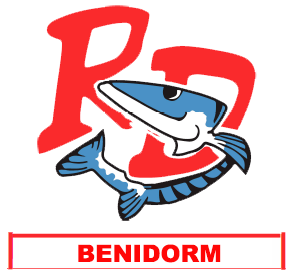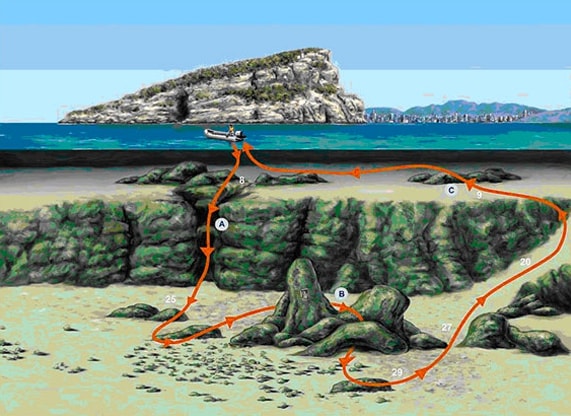LA LLOSA
A fantastic blue abyss at a depth of 33 metres. This location is behind the island of Benidorm (away from the coast and in deep water). A great variety of large fish, octopus and crustaceans can be seen at La Llosa. Occasional strong currents and great feeding must be some of the reasons why the sea life seems so much larger here than those found in places close to the coast. Many consider this to be the most beautiful spot between Calpe and Benidorm.
It is located approximately 300 m south of the island. Its highest point is 6 m from the surface. The environmental conditions of luminosity and hydrodynamism make it a habitat of singular importance. It is frequented by predatory species such as Amberjack, Spiny Dogfish and Dentex. It is also an important refuge for more sedentary species such as moray eels, octopus, different species of bream, etc. The plant component is represented by various species of photophilous infralittoral algae.
At the base of the vertical walls of the island (especially on the N and E sides) there is a seabed made up of numerous rocky blocks, many of which are the result of landslides. At first glance we only discover a large quantity and diversity of fish, but a more detailed observation of the bottom will allow us to distinguish a multitude of invertebrate species hidden among the nooks and crannies of the substratum and algae, which are the main features of the landscape. On the underside of the blocks and loose rocks lives an animal community (infralipidic community) made up of bryozoans, ascidians, sponges, polychaetes, etc.
The size of La Llosa and the numerous motifs of interest allow for several underwater incursions, and there are up to 3 anchoring buoys available for mooring boats. On this occasion we approach the one located furthest north and which descends to the platform, at about -8m. If we follow our course, an absorbing drop appears which, combined with the stupendous visibility that we usually find, will make us glide down to a depth of -29m. Here begins a string of large rocks that provoke a multitude of backlights and are home to abundant life of considerable size such as gilthead bream, dentex, tidy schools of corvina and bream and, more crouched in innumerable hollows, large octopus and colourful moray eels.
The route, following the southern profile of the Llosa to the right, consists of visiting these colossal rocks, some of which are crossed by a tunnel at their base, such as the cave of the Virgin, and then, when the air or the accumulation of nitrogen makes it advisable, approaching the wall of the Llosa where we will find some enormous cracks that we can use as a reference point to continue ascending while continuing to find interesting motifs, this time in the form of numerous and colourful nudibranchs, until we reach the starting point once again.






